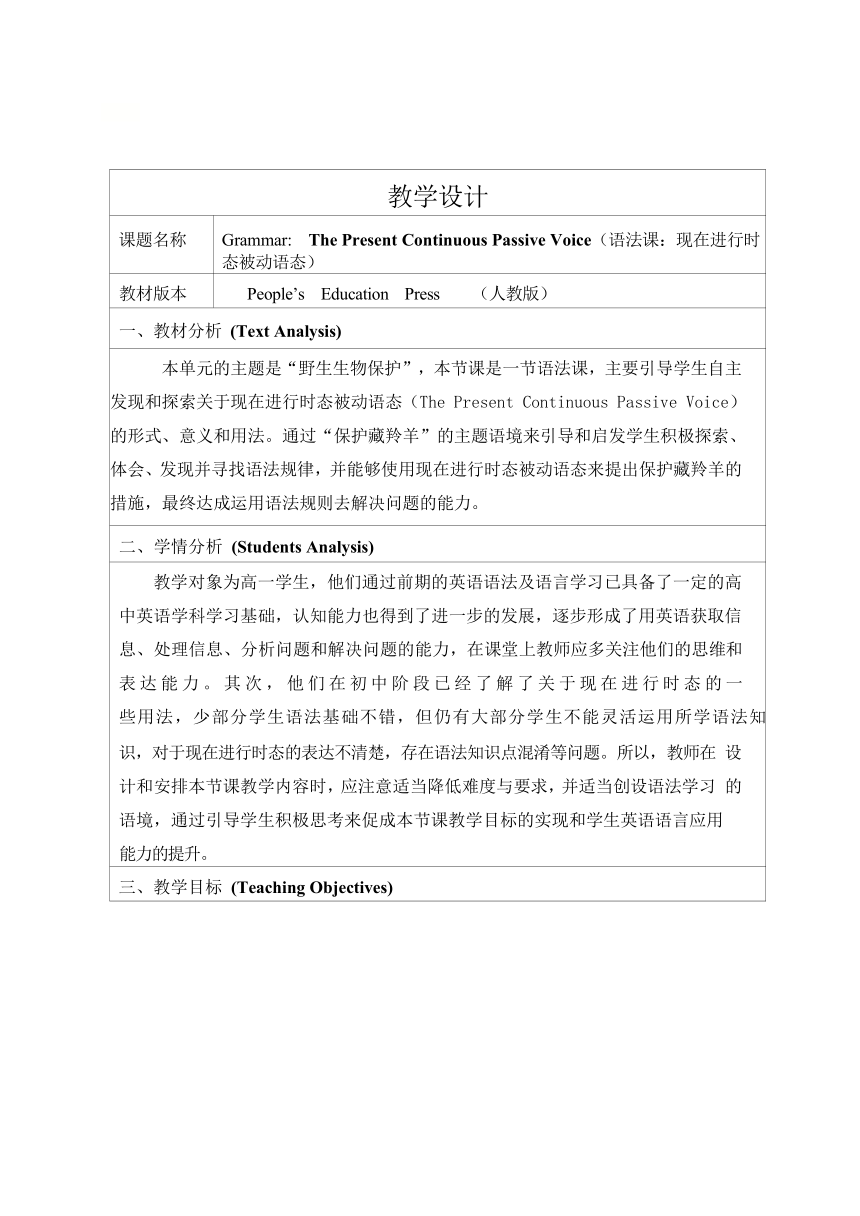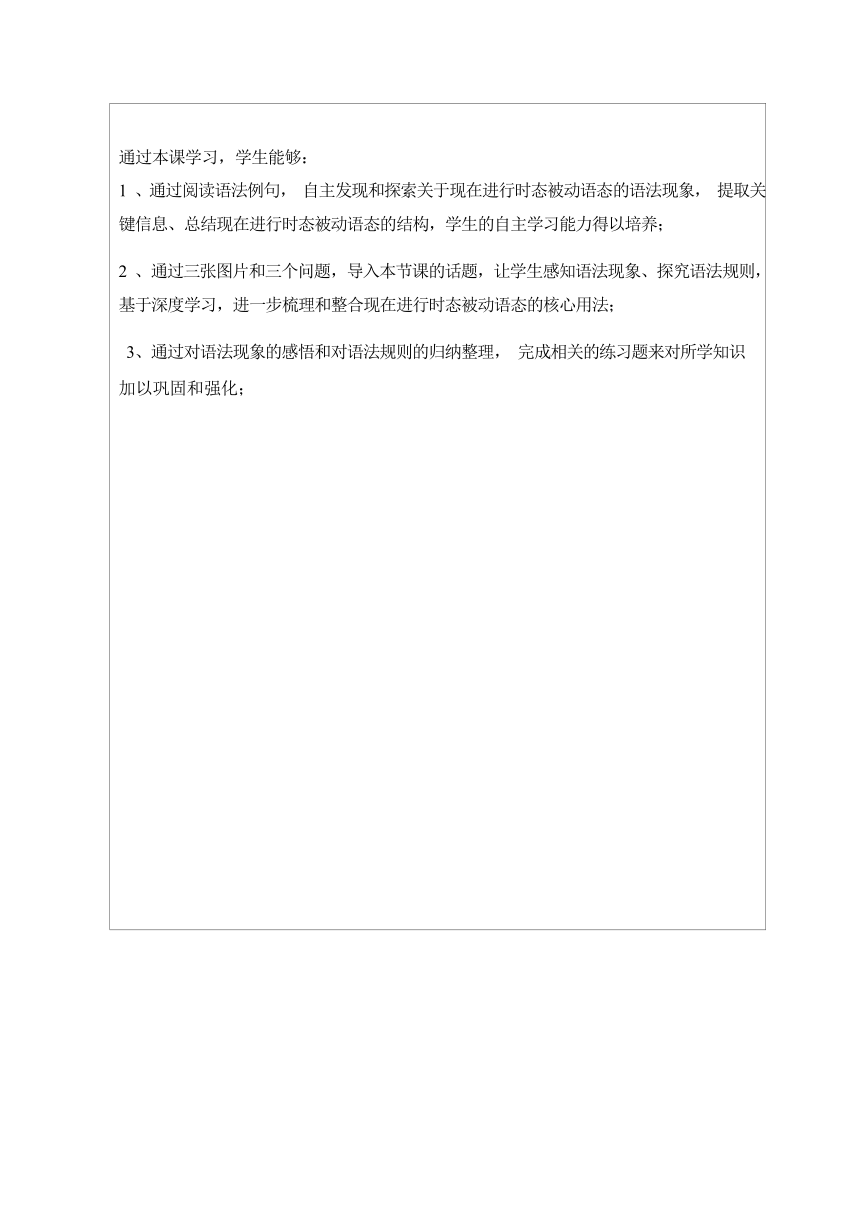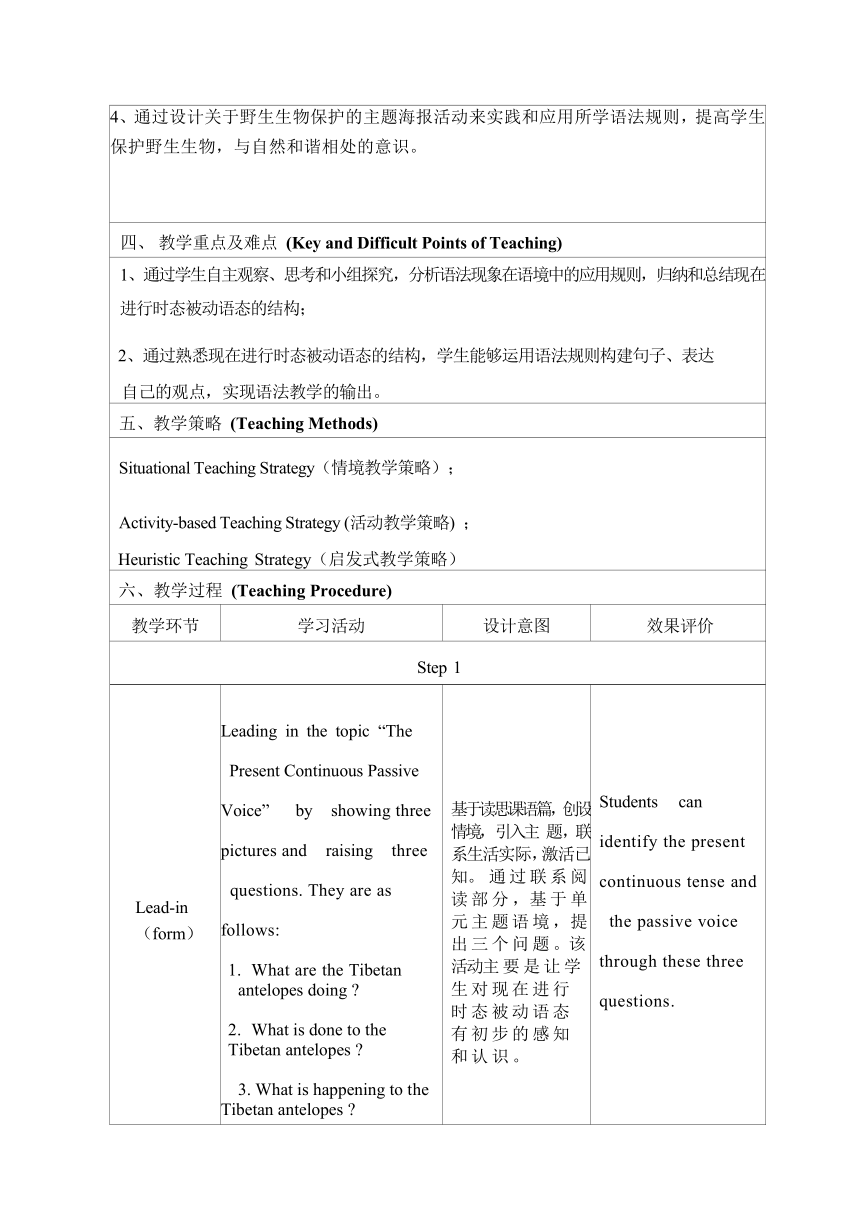 资源简介
资源简介
教学设计
课题名称 Grammar: The Present Continuous Passive Voice(语法课:现在进行时态被动语态)
教材版本 People’s Education Press (人教版)
一、教材分析 (Text Analysis)
本单元的主题是“野生生物保护”,本节课是一节语法课,主要引导学生自主发现和探索关于现在进行时态被动语态(The Present Continuous Passive Voice)的形式、意义和用法。通过“保护藏羚羊”的主题语境来引导和启发学生积极探索、体会、发现并寻找语法规律,并能够使用现在进行时态被动语态来提出保护藏羚羊的措施,最终达成运用语法规则去解决问题的能力。
二、学情分析 (Students Analysis)
教学对象为高一学生,他们通过前期的英语语法及语言学习已具备了一定的高中英语学科学习基础,认知能力也得到了进一步的发展,逐步形成了用英语获取信息、处理信息、分析问题和解决问题的能力,在课堂上教师应多关注他们的思维和表达能力。其次,他们在初中阶段已经了解了关于现在进行时态的一 些用法,少部分学生语法基础不错,但仍有大部分学生不能灵活运用所学语法知 识,对于现在进行时态的表达不清楚,存在语法知识点混淆等问题。所以,教师在 设计和安排本节课教学内容时,应注意适当降低难度与要求,并适当创设语法学习 的语境,通过引导学生积极思考来促成本节课教学目标的实现和学生英语语言应用 能力的提升。
三、教学目标 (Teaching Objectives)
通过本课学习,学生能够: 1 、通过阅读语法例句, 自主发现和探索关于现在进行时态被动语态的语法现象, 提取关键信息、总结现在进行时态被动语态的结构,学生的自主学习能力得以培养; 2 、通过三张图片和三个问题,导入本节课的话题,让学生感知语法现象、探究语法规则, 基于深度学习,进一步梳理和整合现在进行时态被动语态的核心用法; 3、通过对语法现象的感悟和对语法规则的归纳整理, 完成相关的练习题来对所学知识 加以巩固和强化;
4、通过设计关于野生生物保护的主题海报活动来实践和应用所学语法规则,提高学生保护野生生物,与自然和谐相处的意识。
四、 教学重点及难点 (Key and Difficult Points of Teaching)
1、通过学生自主观察、思考和小组探究,分析语法现象在语境中的应用规则,归纳和总结现在进行时态被动语态的结构; 2、通过熟悉现在进行时态被动语态的结构,学生能够运用语法规则构建句子、表达 自己的观点,实现语法教学的输出。
五、教学策略 (Teaching Methods)
Situational Teaching Strategy(情境教学策略); Activity-based Teaching Strategy (活动教学策略) ; Heuristic Teaching Strategy(启发式教学策略)
六、教学过程 (Teaching Procedure)
教学环节 学习活动 设计意图 效果评价
Step 1
Lead-in (form) Leading in the topic “The Present Continuous Passive Voice” by showing three pictures and raising three questions. They are as follows: What are the Tibetan antelopes doing What is done to the Tibetan antelopes 3. What is happening to the Tibetan antelopes 基于读思课语篇,创设情境, 引入主 题,联系生活实际,激活已知。 通过联系阅读部分,基于单元主题语境,提出三个问题。该活动主要是让学生对现在进行时态被动语态有初步的感知和认识。 Students can identify the present continuous tense and the passive voice through these three questions.
Step 2
Read & Find (meaning) Ask Ss to read the passage about “Walking in the Clouds” to find out what is being done by the government to protect the Tibetan antelopes. 通过这一步,学生 的自主学习能力 将会得到训练,并 且启发式教学策 略在这一步将得 以具体体现。 Students can easily find the answers; students can try to summarize the grammar rules.
Step 3
Think & Use (usage\function) At this step, students will explore the grammar rules by reading and discussing the given sentences with their group members, and then they are required to raise some measures using the present continuous passive voice to protect the Tibetan antelopes . Measures: Habitat Appreciation Respect Money Organizing Nature reserve Your attention 学生能够通过小 组探究式学习方 法自主思考、通力 协作,共同发现语法现象和规则,并灵活使用其提出一些保护藏羚羊的措施, 进而增强学生保护野生生物的意识。 Students can fully discuss and explore the usage of the present continuous passive voice in the group, and put forward some measures to protect the Tibetan antelopes using the present continuous passive voice.
Step 4
Practice At this step, students will be able to write short passage about wildlife protection using the present continuous passive voice. 联系情境, 通过对 活动的参与, 学生 能够从简单的半 开放式的语法习 题训练到较为开 放式地应用所学 语法现象, 即,基于本节课的主题语境,提出自己的建议,以保护野生生物。 这一学习 过程中学生对于 语法规则的理解 和应用更加深刻 而具体了,也进一 步增强了学生的 自主思考和合作 学习的能力。 Students can write a short paragraph to protect the wildlife using the present continuous passive voice.
Step 5
Summary Work in groups to make a mind map to briefly summarize the grammar knowledge learned in this Lesson(Ss), and then summarize this lesson by the blackboard design. (T) Culture Awareness in this lesson: Human VS Nature Man and nature form a community of life; we, as human beings, must respect nature, follow its ways, and protect it. -Chinese President Xi Jinping 学生通过小组内 制作关于现在进行时态被动语态的思维导图,在组内进行交 流总结, 对于本节 课所学内容会有 更加深刻的理解,同时也激发了学生保护野生生物、与大自然和谐相处的意识。 Students will be able to do a mind map to present the present continuous passive voice they learned in the lesson and introduce it to their partners.
七、作业设计(Homework Design)
Option 1. Finish the writing part in the handout. Option 2. Design a poster about wildlife protection in groups.
板书设计(Blackboard Design)
九、教学评价(Teaching Evaluation)
学生学习评价(Learning Assessment) 1. Can you present and list the structure and the usage of the present continuous passive voice 2. Answer the following questions and fill in the blanks with the appropriate form of the present continuous passive voice. Write about the situation of Influenza A (甲流) in China. These days, we (face) a big problem, which is a kind of virus called Influenza A. Luckily, many things are (do) by lovely people. Patients (treat) by doctors. Medicines (develop) by scientists. Supports (offer) by volunteers. We are sure we will defeat it and have a happy life soon. Design a poster about wildlife protection in groups using the present continuous passive voice. 教学反思 (Teaching Reflection) 本节课是一节语法课,主要运用情境式教学策略、活动式教学策略和启发式教学策略来引导学生学习现在进行时态的用法。在备课的过程中,本人根据学生的实际学习情况,基于教材,又不局限于教材,大胆创新,利用小组竞赛和课堂趣味练习等游戏形式,设置学生活动,全方位地训练学生运用一般将来时的能力。以下是我对这节课的教学反思: 1、反思亮点: (1)本节课的设计与制作过程中兼顾了课堂的知识性与趣味性,为学生营造了一个藏羚羊正在遭受迫害的情境,迅速引入主题,激活已知; (2)再加之本节课为语法课,所以在授课过程中教师注重利用启发式教学策略 来引导学生自主思考、探索并发现语法规律与语言现象,颠覆了传统课堂的语法教 学,打破刻板印象,开阔了学生的思维,激发了学生的英语语法学习兴趣,并能够 有所收获; 文化意识的培养潜移默化,循序渐进; 板书设计精美,切合主题语境。 2、反思不足: (1)在语法规则的探索和启发环节可以适当多增加一些时间,给予学生充分的 时间进行小组合作探究学习,由于学生语法基础较弱,所以在自己动手探索语法规 则时需要的时间要略长一些; (2)授课过程中注意语速不能太快,尤其是用英语进行表达或陈述时,根据学生 的理解能力进行适时的调整; (3)小组合作探讨时,部分同学产生依赖心理,没有大胆地表现自己的想法。 3、重构设想: (1)下次应合理掌控课堂时间,提前对每一环节的用时进行设计,并且在输出部 分应设置分层练习来帮助不同接受水平的学生巩固新学语法知识,使学生学有所获; (2)今后在教学过程中,组织小组活动时要有一个都不能少的精神,鼓励每个小 组成员承担不同的学习任务、积极参与到学习活动中来。 总之,语法课堂要高效又有效,是个值得研究和探讨的课题。今后会在实践中不 断创新,勤于总结,争取更大的进步。
展开更多......
收起↑
 资源预览
资源预览





 资源预览
资源预览




